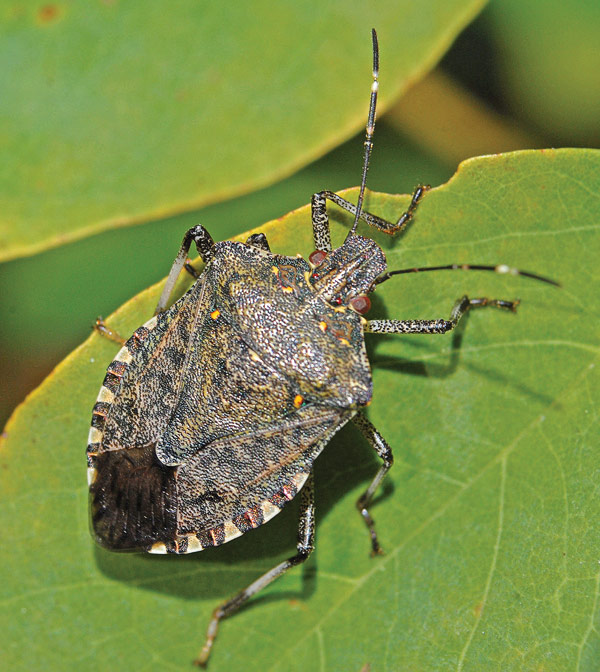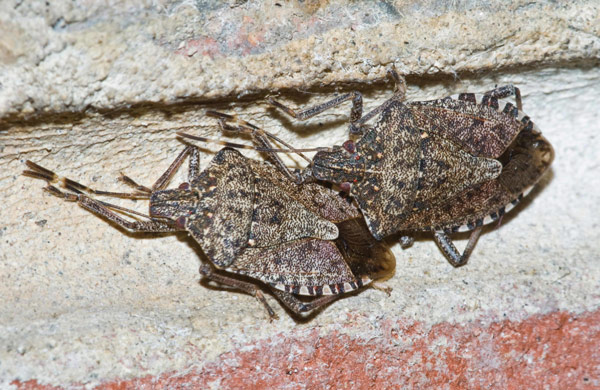Brown Marmorated Stink Bugs: When You Go Inside To Escape the Autumn Chill, They're Not Far Behind
 |
|
Adult brown marmorated stink bug. Photo: Hectonichus, CC BY-SA 4.0. |
By Marcia Anderson, PhD, LTE, U.S. EPA
As cooler weather approaches, many pests try to find their way into warmer buildings, such as schools, barns, and homes. Stink bugs—including the brown marmorated stink bug (BMSB)—are no exception.
Outdoors in early autumn, stink bugs can be found hanging out on screens and on the bark of certain trees. The fall equinox—on or around September 22—sets off the fall stink bug migration.
How Did BMSB Arrive in the U.S.?
Accidentally imported from Asia into the United States, BMSB was first observed in Allentown, Pennsylvania, in 1998 (Jacobs, S., 2010).
With few natural predators in North America, BMSB has become widely recognized as a significant threat to agriculture, capable of causing catastrophic damage to certain crops. And research to control the pest and limit its effects is ongoing.
But BMSB can also be a challenging nuisance pest in residential settings, especially as the colder seasons set in.
How and Why Do They Choose Their Overwintering Sites?
An important component of managing many pests is to learn their habits and habitats and use that knowledge against them. BMSB is no exception.
According to Tracy Leskey of the USDA Agricultural Research Service, who conducted an “elevation trends for dispersal” study, it turns out that they like higher elevations. Then they seek out specific characteristics of buildings or homes.
Why Would They Choose My Home over the House down the Street?
BMSBs seem to prefer darker house colors; however, they will still land on white houses, but not as often and not in comparable numbers. Next, they favor natural materials, such as wood, stone, or brick, as opposed to vinyl siding. The bugs like the north and east sides of buildings because they are typically cooler and damper.
Stink bugs can easily find cracks and crevices in foundations and gaps around window frames, soffits, and openings where pipes or wires enter the building. The bugs flatten their little bodies and squeeze through tiny openings, just letting themselves into any building they find attractive.
Once inside, they migrate toward tight, dry, concealed locations, like attic spaces, knee walls, and unheated portions of the attic.
The stink bugs seem to prefer darker house colors, natural materials, and the north and east sides of buildings, which are typically cooler and damper.
If they move into your living spaces, they are often looking for moisture, such as potted plants, pet water bowls, bathrooms, and kitchens. Also, if you find one stink bug inside, chances are you will find more not too far away, as stink bugs are typically found in aggregations. Researchers have also found that the weaker bugs become active first as they break from their hibernation.
Stink bugs originally got their name from the rotting smell they give off when threatened or crushed. Since nobody wants their home to smell like rotting food, it’s important to have a stink bug control plan in place if you begin noticing them around your home. If you step on one or crush it, you will quickly understand where it got its name.
A Regrettable—and Unforgettable—Holiday Encounter
My own stink bug encounter began just prior to the holidays, when my husband and son went on their annual Christmas tree hunt. They came home with a lovely tree that was home to our lights, ornaments, and garlands, and filled our home with the fresh scent of spruce.
Christmas came and went, and while taking off the lights and ornaments, I found shield-shaped bugs crawling out from the trunk along the branches. For the next four months, my house was overrun with the most putrid-smelling bugs that I have ever encountered.
Delayed Effects of Temperature and Food Availability
When we brought the tree into the house from the cold outdoors, the stink bugs began to wake from their winter slumber. As long as the tree was fresh, the stink bugs blissfully drank its sap. However, as the tree dried, the sap was no longer available, so the stink bugs began to explore the house looking for another meal.
They targeted the bathrooms and the kitchen, which have a ready water source, and any room with houseplants. They even swam in the dog’s water dish. All winter long, I battled stink bugs. They made the vacuum smell and the dog stank. I soon found the easiest way to get rid of them was to give them an eternal swim (flush) down the porcelain whirlpool.
Avoiding a Similar Experience in Your Home
If you are selecting a fresh-cut tree, bring a strong flashlight. Check the trunk carefully and the undersides of the branches for the characteristically brown, shield-shaped bugs.
If you squeeze them, you will quickly learn how they got their name. Better advice: If you find them, look for a different tree.
Want To Avoid a Winter-Long Battle?
Inspection, detection, exclusion, sanitation, and maintenance are a few of the key components of IPM. Often, it takes detective work and ingenuity to discover how and where pests are entering your home.
Even if you take steps to avoid unknowingly bringing stink bugs into your home, they will still be looking for overwintering sites and exploiting the aforementioned structural vulnerabilities to gain access.
Be pest wise. Follow an integrated pest management (IPM) action plan.
Inspection, detection, exclusion, sanitation, and maintenance are a few of the key components of IPM, a smart, sensible, and sustainable approach to pest control. Often, it takes detective work and ingenuity to discover how and where pests are entering your home.
How to Prevent Sharing Your Home with These Rancid-Smelling Pests
 |
|
Adult stink bugs. Photo: Susan Ellis, Bugwood.org. |
First, Work To Keep Them Out
Combat them before they get in by practicing good exclusion.
The bugs flatten their bodies and squeeze through windows, cracks, or other openings within the walls.
Make sure all your window screens fit securely and tightly, vents are screened, and door and window frames have no gaps. Removal of window air conditioners is important, as numerous BMSBs will enter this way. Sealing around baseboards and areas where cables and wires enter your building will help keep stink bugs out. Expandable foam caulk can be used for larger gaps. Check under doors to ensure door sweeps are in good condition and do not leave any gaps.
In homes, other major points of entry are fireplaces, firewood, and chimneys. Close your flue when the fireplace is not in use.
Second, Deal with Stink Bugs That Do Gain Entry
If small numbers occur indoors, they can be removed either by hand or by using a shop-grade vacuum. Vacuum cleaners can sweep up both live and dead stink bugs. However, be warned: this use may permanently infuse the stink into your vacuum.
Be sure to remove the dead bugs, as the rotting carrion smell will attract even more stink bugs and other insects.
For attic infestations, have a pest management professional treat the attic spaces. Diatomaceous earth can be used for limited stink bug control outdoors, in basements and attics, and around foundations.
During my own experience around the holidays, I found that placing a large bowl or turkey pan of water mixed with dishwashing liquid on the floor of my kitchen will attract and drown the bugs. For even greater efficacy, place a desk lamp near the bowl and turn it on. You may wish to place the dead bugs in zip-top bags before discarding them to prevent the stink from permeating your garbage area.
Managing BMSB as a Nuisance Pest
Although BMSB remains a significant agricultural pest, the good news is that it poses no substantial risk to structures or people. However, it is a horrid nuisance in residential settings.
Fortunately, homeowners can help manage and limit the problem by using some key IPM techniques. This includes understanding what attracts BMSBs, how they get in, and what they look for once they’re inside your home. This information can then be used as the basis for strategies against the invading pests.
Sources and Further Reading
Penn State Extension – Brown Marmorated Stink Bug: extension.psu.edu/brown-marmorated-stink-bug (Steve Jacobs)
StopBMSB.org – state-by-state: www.stopbmsb.org/where-is-bmsb/state-by-state/ (website maintained by the Northeastern IPM Center)
Rutgers New Jersey Agricultural Experiment Station – Monitoring for the Brown Marmorated Stink Bug: njaes.rutgers.edu/stink-bug/
